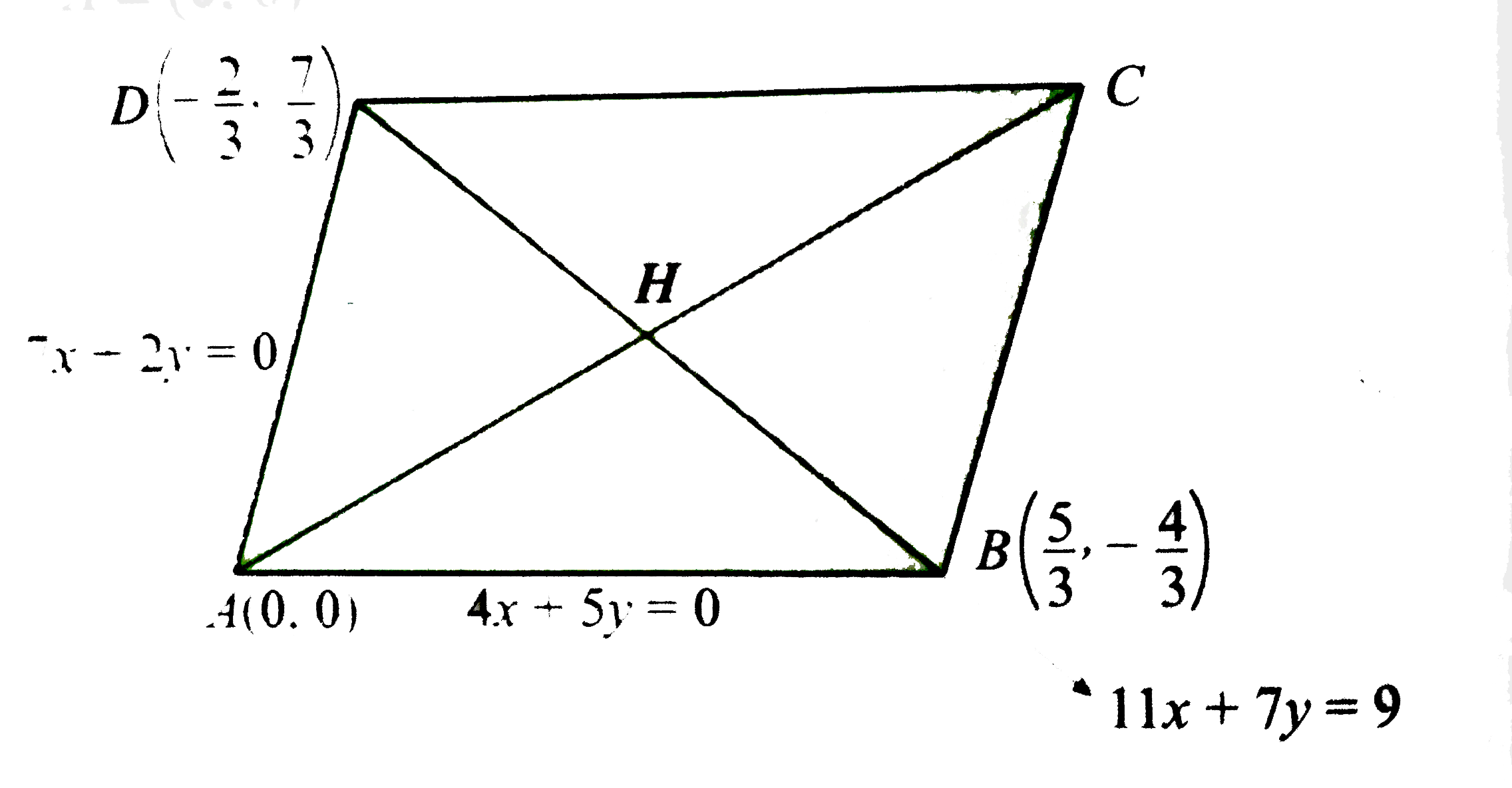Two consecutive sides of a parallelogram are 4x+5y=0 and 7x+2y=0 . If the equation of one diagonal is 11x=7y=9, find the equation of the other diagonal.
Let the equations of sides AB and AD of the parallelogram ABCD be as given in (1) and (2), respectively, i.e.,
4x+5y=0 (1)
and 7x+2y=0 (2)
Solving (1) and (2), we have

x = 0, y =0
∴A≡(0,0)
The equation of one diagonal of the parallelogram is
11x+7y=9 (3)
Clearly, A(0,0) does not lie on the diagonal as shown in (3).
Therefore, (3) is the equation of diagonal BD.
Solving (1) and (3), we get B -=(5/3,-4/3).
Solving (2) and (3), we get D -= (-2/3, 7/3).
Since H is the middle point BD, we have
H≡(12,12)
Now, the equation of diagonal AC which passes through A(0,0) and H(1/2, 1/2) is
y−0=0−(1/2)0−(1/2)(x−0) or y−x=0
Topper's Solved these Questions
- STRAIGHT LINESBOOK - CENGAGECHAPTER - STRAIGHT LINESEXERCISE - Exercise 2.1
23 Videos
- STRAIGHT LINESBOOK - CENGAGECHAPTER - STRAIGHT LINESEXERCISE - Exercise 2.2
4 Videos
- STRAIGHT LINEBOOK - CENGAGECHAPTER - STRAIGHT LINEEXERCISE - Multiple Correct Answers Type
8 Videos
- THEORY OF EQUATIONSBOOK - CENGAGECHAPTER - THEORY OF EQUATIONSEXERCISE - JEE Advanced Previous Year
9 Videos
Similar Questions
Two consecutive sides of a parallelogram are 4x+5y=0 and 7x+2y=0 . If the equation of one diagonal is 11x=7y=9, find the equation of the other diagonal.
View SolutionTwo consecutive sides of a parallelogram are 4x+5y=0adn7x+2y=0. If the equation of one diagonal is 11x+7y=9, Equation of other diagonal : (A) 11x+7y=0 (B) 3x−5y+5=0 (C) 7x+11y=0 (D) 3x+5y+5=0
View Solution
Knowledge Check
Two adjacent sides of a parallelogram are 4x+5y=0and7x+2y=0. if the equation of it's one diagonal be 11x+7y=9,
Area of parallelogram isA3B43892C6D2√853Two adjacent sides of a parallelogram are 4x+5y=0,and7x+2y=0.
Area of the parallelogram isA3B32C6D2√853Two sides of a parallelogram are along the lines 4x + 5y = 0 and 7x + 2y = 0. If the equation of one of the diagonals of the parallelogram is 11x + 7y = 9, then other diagonal passes through the point :
A(1,2)B(2,3)C(2,1)D(1,3)
The two adjacent sides of parallelogram are y = 0 and y=√3(x−1). If equation of one diagonal is √3y=(x+1), then equation of other diagonal is
View SolutionTwo sides of a parallelogram having equation 4x+5y=0and7x+2y=0. One of the diagonal is 11x+7y=9. Then the other diagonal will surely passes through
View SolutionTwo sides of a parallelogram are x+y+1=0&2x−y+2=0. One of its diagonal is 13x−2y−32=0 Equation of other diagonal is
View SolutionIf the lines represented by 2x2−5xy+2y2=0 be the sides of a parallelogram and the line 5x+2y=1 be one of its diagonal. Find the equation of the other diagonal, and area of the parallelogram .
View Solution3x−2y+1=0and2x−y=0 are the equation of the sides ABandAD of the parallelogram ABCD and the equation of a diagonal of the parallelogram is 5x−3y−1=0. The equation of the other diagonal of the parallelogram is : (A) x−y+1=0 (B) x−y−1=0 (C) 3x+5y+13=0 (D) 3x+5y=13
View Solution
